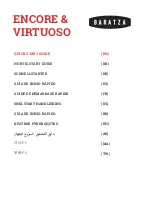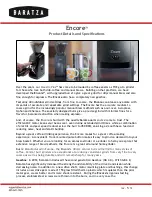
17
Grinding Operations
Selecting Grinding Wheels
Before using a grinding wheel, be certain that its maximum safe operating speed is not
exceeded by the nameplate speed of the grinder. Do not exceed the recom mended wheel
diameter.
Disc Grinding Wheels
WARNING
Grinding wheels should be carefully selected in order to use the grinder
most efficiently. Wheels vary in type of abrasive, bond, hardness, grit size
and structure. The correct type of wheel to use is determined by the job. Use disc grinding
wheels for fast grinding of structural steel, heavy weld beads, steel casting, stainless steel and
other ferrous metals.
Grinding Tips
Efficient grinding is achieved by controlling the
pressure and keep ing the angle between wheel
and workpiece at 10° to 15°. If the wheel is flat,
the tool is difficult to control. If the angle is too
steep, the pressure is concentrated on a small area causing burning to the work surface.
WARNING
Excessive or sudden pressure on the wheel will slow grinding action and
put dangerous stresses on the wheel.
When grinding with a new wheel be certain to grind while pulling tool backwards until wheel
becomes rounded on its edge. New wheels have sharp corners which tend to “bite” or cut into
work piece when pushing forward.
Sanding Operations
Selecting Sanding Disc
Sanding discs are made of extremely hard and sharp aluminum oxide grits, phenol-resin
bonded to a sturdy fiber backing for fast heavyduty service and long life. The discs vary as to
size and spacing of the abrasive grits. OPEN COAT (type H) — used for soft materials and
on paint or varnish. CLOSED COAT (type K) —used for metal, hardwood, stone, marble and
other materials.
Sanding discs range in grit from 16 (very coarse) to 180 (very fine). To obtain best results,
select sanding discs carefully. Many jobs require the use of several grit sizes and at times
both “open coat and closed coat” discs are required to get the job done faster. See chart for
application examples.
OPERATION: Refinishing painted wood or metal surfaces.
REMARKS
GRIT
To remove paint and to smooth surface irregularities.
Coarse 16-24-30
To smooth the rough sanding.
Medium 36-50-80
To remove scratches left by previous discs.
Fine 100-120
To smooth surfaces for painting, polishing or waxing.
Very Fine 150-180
Summary of Contents for 9295
Page 70: ...70...
















































